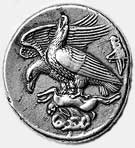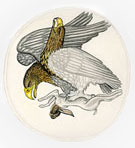
Plate 25 |

Plate 26 |
|
Akragas (present-day Agrigento), so perhaps the image was a coat of arms. Still extant in Agrigento are the remains of a large temple dedicated to Zeus, built during the reign of Theron (488–472 BCE), more than half a century before this coin was minted.[52]
Science
In ancient Greece the eagle was a symbol of victory, freedom and Zeus. Two eagles feeding on a pregnant hare constituted a powerful metaphor about overtaking a vulnerable but rapidly growing community; the biological message is clear even though it reflects a sophisticated ecological principle. The hare is an animal associated in contemporary as well as ancient times with “irruptive” population cycles: boom years with high birthrates, are followed by low-density “bust” years as resources become sparse from overconsumption. A significant increase in the population of hares (the prey) will lead to a significant increase in the population of eagles (the predators). But the balance between predator and prey is self-regulating. If the
prey population overwhelms its resources or invites disease, it will crash, to be followed by a sharp reduction in an increasingly hungry predator population.[53] When the Greek dramatist Aeschylus used the metaphor in his play Agamemnon (458 BCE), it served as a dramatic reminder that military success always bears the hidden cost of future
Page 3--> |
Plate 25 Ten Drachma Silver Coin, Arkagas, Sicily,
c. 412–411 BCE, by an unknown artist
Photo credit: Max Hirmer. © Hirmer Fotoarchiv München.
Plate 26 Modified Detail of Ten Drachma Silver Coin, Arkagas, Sicily,
© 1990/2007 Darryl WheyeScience Art--Birds.
© 2008 Darryl Wheye and Donald Kennedy
|


